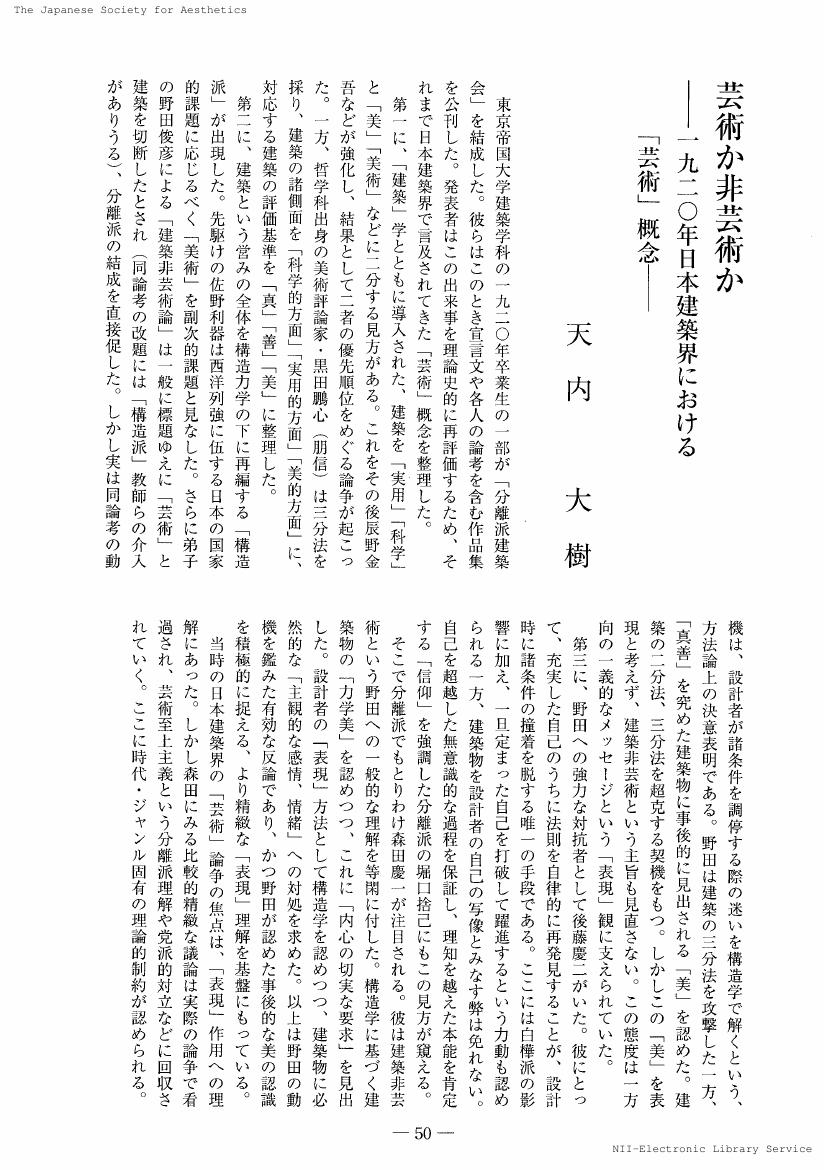4 0 0 0 OA 大学生協のガバナンスとリスク管理について~文芸大生協で発生した不正の事例から~
- 著者
- 佐々木 哲也 天内 大樹 下澤 嶽 ササキ テツヤ アマナイ ダイキ シモサワ タカシ Tetsuya SASAKI Daiki AMANAI Takashi SHIMOSAWA
- 雑誌
- 静岡文化芸術大学研究紀要
- 巻号頁・発行日
- vol.23, pp.151-160, 2023-03-31
大学生協は、法令に基づき、学生や教職員らの組合員により組織された機関によって民主的に運営されている。多くの大学生協は全国大学生活協同組合連合会や各地の事業連合に加盟しており、これらの組織から支援を受けつつ、専従の生協職員を雇用して事業を行っている。これにより多様なサービスの安定的・効率的な供給を実現させている一方で、機関運営と事業運営とが隔てられ、組合員による機関運営の役割や裁量は限定的なものとなり、ガバナンスの形骸化という組織運営上の問題を抱えている。 静岡文化芸術大学生活協同組合(以下、文芸大生協)では、2021年度に当時雇用していたパート職員が文芸大生協の資産を不正に取得する被害が発生し、これに対して、損失の処理、情報公開、不正の再発防止などの対処を行った。同様の不正の被害は全国の大学生協で散発しているものの、過去の事例を参照できず、文芸大での不正の対処は困難を極めた。また、不正の再発防止において対策にかかるコストや役員の負担などの難しい課題を残すなど、大学生協のガバナンスの問題を浮き彫りにした。 本稿では、文芸大生協での不正とその対処を事例として報告した上で、大学生協のリスク管理の改善には、全国・地域単位での多層的なガバナンスの構築と、大学の主体的な関与が必要であることを提示する。
1 0 0 0 OA 分離派建築会結成の理論的背景 : 初期日本建築界における「芸術」と「表現」
- 著者
- 天内 大樹
- 出版者
- 美学会
- 雑誌
- 美学 (ISSN:05200962)
- 巻号頁・発行日
- vol.57, no.4, pp.69-82, 2007-03-31 (Released:2017-05-22)
The author examines architectural theories that lead to the founding of Bunriha Kenchiku Kai (Secessionist Architectural Group) in 1920, in line with four phases focusing on the understandings of "expression". First of all, the notion of architecture was divided into "art" and "science/utility" when it was introduced to Japan from the West. Secondly, the "art" was relegated to a lower importance through Sano Toshikata's nationalistic view of architecture. Sano's follower Noda Toshihiko subordinates architectural design only to the theory of structural mechanics. Their understandings of "expression" were unilinear. Thirdly, Goto Keiji, Noda's adversary in study, believed that principles of architectural design are to be rediscovered within architects' self: he became an predecessor of Bunriha. Moreover, a Bunriha architect Horiguchi Sutemi insisted on "life" and "faith" within one's instinct. But their discussions deemed architecture only as reflections of the "self/life". Finally, the integration of self and architecture took place when another Bunriha architect Morita Keiichi discovered "inner demand" in the "beauty of dynamics" of the building. However, his understanding of "expression" remained unargued by the surrounding architects due to the theoretical constraints. This has affected our view of Bunriha.
- 著者
- 天内 大樹
- 出版者
- 美学会
- 雑誌
- 美学 (ISSN:05200962)
- 巻号頁・発行日
- vol.56, no.3, pp.50, 2005-12-31 (Released:2017-05-22)
- 著者
- 天内 大樹
- 出版者
- 美学会
- 雑誌
- 美学 (ISSN:05200962)
- 巻号頁・発行日
- vol.56, no.3, 2005
- 著者
- 天内 大樹
- 出版者
- 大正イマジュリィ学会
- 雑誌
- 大正イマジュリィ (ISSN:13496719)
- 巻号頁・発行日
- no.4, pp.90-111, 2008
- 著者
- 天内 大樹
- 出版者
- 日本建築学会
- 雑誌
- 建築雑誌 (ISSN:00038555)
- 巻号頁・発行日
- no.1660, 2014-07-20
- 著者
- 天内 大樹
- 出版者
- 美学会
- 雑誌
- 美学 (ISSN:05200962)
- 巻号頁・発行日
- vol.57, no.4, pp.69-82, 2007
The author examines architectural theories that lead to the founding of Bunriha Kenchiku Kai (Secessionist Architectural Group) in 1920, in line with four phases focusing on the understandings of "expression". First of all, the notion of architecture was divided into "art" and "science/utility" when it was introduced to Japan from the West. Secondly, the "art" was relegated to a lower importance through Sano Toshikata's nationalistic view of architecture. Sano's follower Noda Toshihiko subordinates architectural design only to the theory of structural mechanics. Their understandings of "expression" were unilinear. Thirdly, Goto Keiji, Noda's adversary in study, believed that principles of architectural design are to be rediscovered within architects' self: he became an predecessor of Bunriha. Moreover, a Bunriha architect Horiguchi Sutemi insisted on "life" and "faith" within one's instinct. But their discussions deemed architecture only as reflections of the "self/life". Finally, the integration of self and architecture took place when another Bunriha architect Morita Keiichi discovered "inner demand" in the "beauty of dynamics" of the building. However, his understanding of "expression" remained unargued by the surrounding architects due to the theoretical constraints. This has affected our view of Bunriha.
1 0 0 0 国家に保障された職能、建築家
- 著者
- 天内 大樹
- 出版者
- 一般社団法人日本建築学会
- 雑誌
- 建築雑誌 (ISSN:00038555)
- 巻号頁・発行日
- vol.121, no.1546, 2006-04-20
